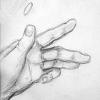I'm thinking what is the easiest and fastest and most efficient way to make decent looking art for an isometric RPG like baldurs gate for example.
I'm new to making art for games and I've only tried making a 3D character so far and it went well.
But it just seems a lot harder to make 2D art... Because with a 3D model you can simply animate it by moving and rotating body parts..
but with a 2D model you have do recreate the character every frame of an animation.. Which works fine if you are making ultra oldschool where you can barely make out that the character is a humanoid.. But where you want smoother animations where arms don't teleport and you wan't many animations for idle, walk, run, lots of different attacks and you want to be able to do all that in all direction which is at least 8 for it to look decent.
With 3D model you can create a extremely low poly character (easy and fast work) if it's just going to look oldschool decent like planescape torment for example.. and then texture it only once unlike 2d character which needs to be textured 1 million times for each frame of every single animation in every single direction.
Or maybe I just don't know much about making 2D art.. if that's the case can someone link me to a good tutorial?
I'm assuming I must be wrong otherwise I don't see the advantage to making 2D art for games.
Is it easier making 2D art?
Because look at when BG was created. 1998. Do you honestly think they had consumer-grade 3D graphics cards that could render the detail of an Infinity Engine scene in realtime 3D in 1998? The Infinity Engine was a good compromise for the time, allowing a highly detailed (if static) scene for relatively little gpu cost. They could do such a scene now relatively easily, but in 1998? No way.
To answer your original question, I personally find it easier (as an un-skilled artist) to create 2D graphics by way of pre-rendered 3D than by hand drawing. Using tools such as Sculptris or Blender's sculpt mode, you can create fairly detailed artwork in a very intuitive fashion. After that, the rest of the process is a technical one. You might check out this journal post by JTipetts, where he talks about the workflow from the perspective of a programmer. It's a bit rough, him/her not being a professional artist, but it's still interesting.
Your specific example makes it a tough call.
Yes, if you go 2D you would have to do a different drawing for each frame of animation, for each angle, for each asset you want to be able to see from different angles.
Not exactly a million though - a basic walk cycle can be done with as little as 2 frames, while 8 frames is the classic.
If you aren't rotating the camera, and you have static objects, i.e. crates, you only have to do one drawing.
If you do 3D you will have to model, rig, unwrap UVs, paint textures, bake lights, paint weights, and animate.
This will give you more flexibility, and allow you to play with the camera. It's a very different process, and different artists may find it harder/easier.
Yes, if you go 2D you would have to do a different drawing for each frame of animation, for each angle, for each asset you want to be able to see from different angles.
Not exactly a million though - a basic walk cycle can be done with as little as 2 frames, while 8 frames is the classic.
If you aren't rotating the camera, and you have static objects, i.e. crates, you only have to do one drawing.
If you do 3D you will have to model, rig, unwrap UVs, paint textures, bake lights, paint weights, and animate.
This will give you more flexibility, and allow you to play with the camera. It's a very different process, and different artists may find it harder/easier.
I was wondering this too. What I myself wanted to know is, how much time does it take to make a 3d sculpture? How much more time to rig it?
I've timed myself in 2d art and know how much quality I'm able to get from the amount of hours I put into an artwork. Is it possible to make a 3d sculpture in an hour?
Also, to the topic maker, is it possible to see this 3d model that you've made? And how much time did it take you to build it?
I've timed myself in 2d art and know how much quality I'm able to get from the amount of hours I put into an artwork. Is it possible to make a 3d sculpture in an hour?
Also, to the topic maker, is it possible to see this 3d model that you've made? And how much time did it take you to build it?
Absolutely.
Is it possible to make a 3d sculpture in an hour?
Is it possible for you? We don't know. Different people have different abilities, and what's possible for one artist may be difficult or impossible for another. People also have different levels of experience, and the best 3d modeller in the world may not be able to match your 2d capabilities; perhaps you couldn't create a 3d model in one hour now, but you might (or might not) be able to learn to do so.
You also need to take in to account the desired quality and style of the end-product. There's a huge difference between a simple 3d model and a very complex and detailed one, and the same variation is also present in 2d art.
how much time does it take to make a 3d sculpture? How much more time to rig it?
How long is a piece of string?
It depends both on the specifics of the sculpture in question, and on the skills of the artist in question. Going back to your example time of one hour, a talented artist with good tools can create quite a complex and detailed model in that time -- but again, it very much depends on the specifics of the situation.
I don't see the advantage to making 2D art for games.
In some cases the code for loading and display of 2d art might be simpler. The hardware on the target platform (think mobile devices) might be better able to render a sufficient number of 2d assets at a desired frame-rate than 3d. Depending on the formats, you might be able to store your 2d assets in less space than 3d. Some teams have access to a skilled 2d artist, but not a skilled 3d artist.
Note that the depending on the situation the opposite of every one of these examples might also be true.
It's always a trade-off, and there is no single choice that is better in all situations -- you need to look at the specifics of your own situation and make a decision about what works for you.
2D art is easier. 3D animation has the illusion of being easier with graph based inbetweens but good animation is done one frame at a time no matter how you do it. To build a decent 3D game character a modeler needs to model and texture the character (2D art), rig it and pose at least 16 frames to get some decent animation on the character for one action. In that time an artist could draw 24 frames of smooth animation for a slick character in 8 directions and move onto other actions if they're a decent artist. The only bonus to the 3D character is the camera angles that can explore the character's action from multiple angles. But if you have a locked view then I would suggest 2D.
If you want to explore a huge variety of animation and interactions (hope so) then I would suggest creating 3D art and rendering 2D isometric images of the animation to create 2D sprites for a 3D world. The cool thing about this method is that you can create a bump map on the 2D sprite images that can gather real time lighting and the character can have subtle highlights and shadows as they move through the world.
If you want to explore a huge variety of animation and interactions (hope so) then I would suggest creating 3D art and rendering 2D isometric images of the animation to create 2D sprites for a 3D world. The cool thing about this method is that you can create a bump map on the 2D sprite images that can gather real time lighting and the character can have subtle highlights and shadows as they move through the world.
This topic is closed to new replies.
Advertisement
Popular Topics
Advertisement








